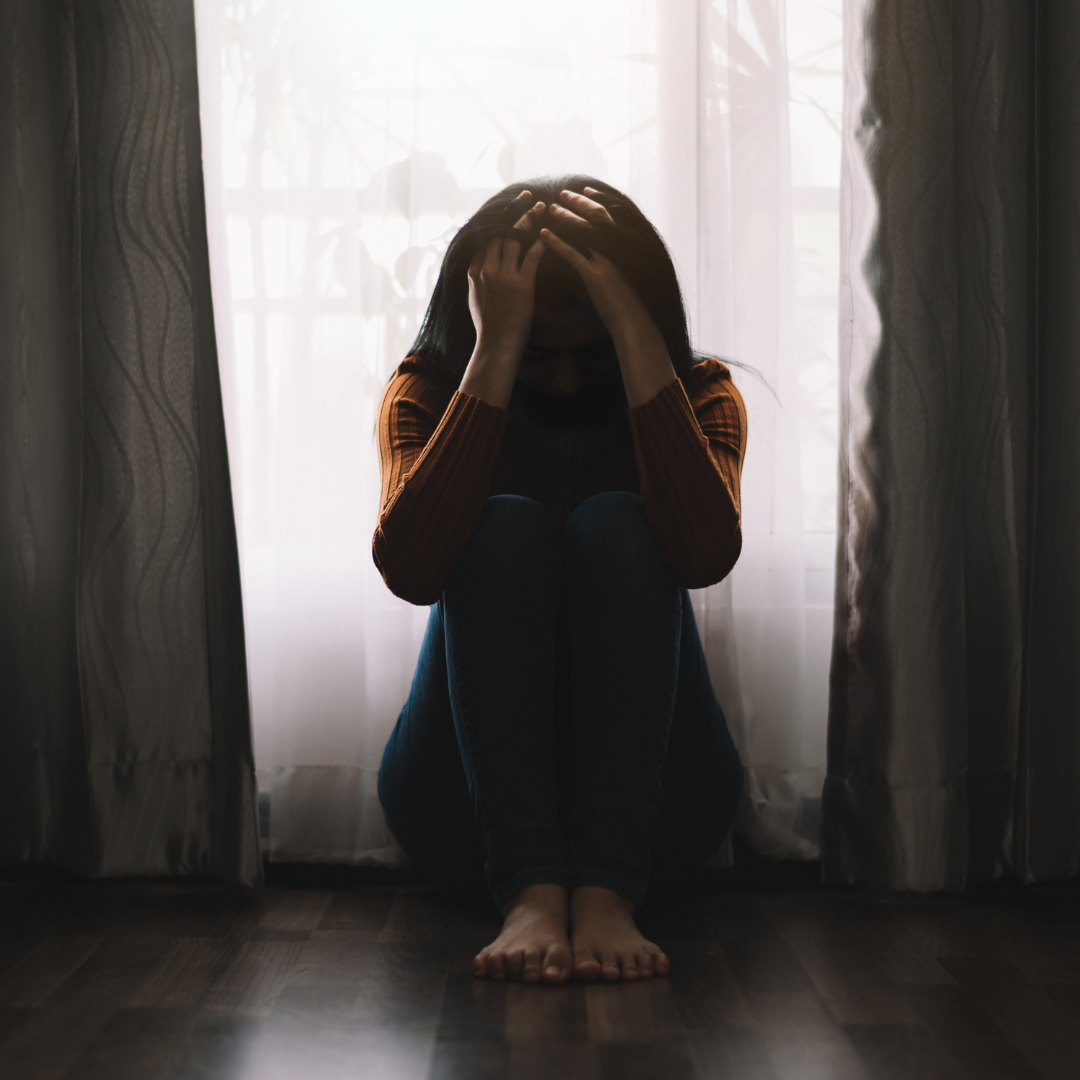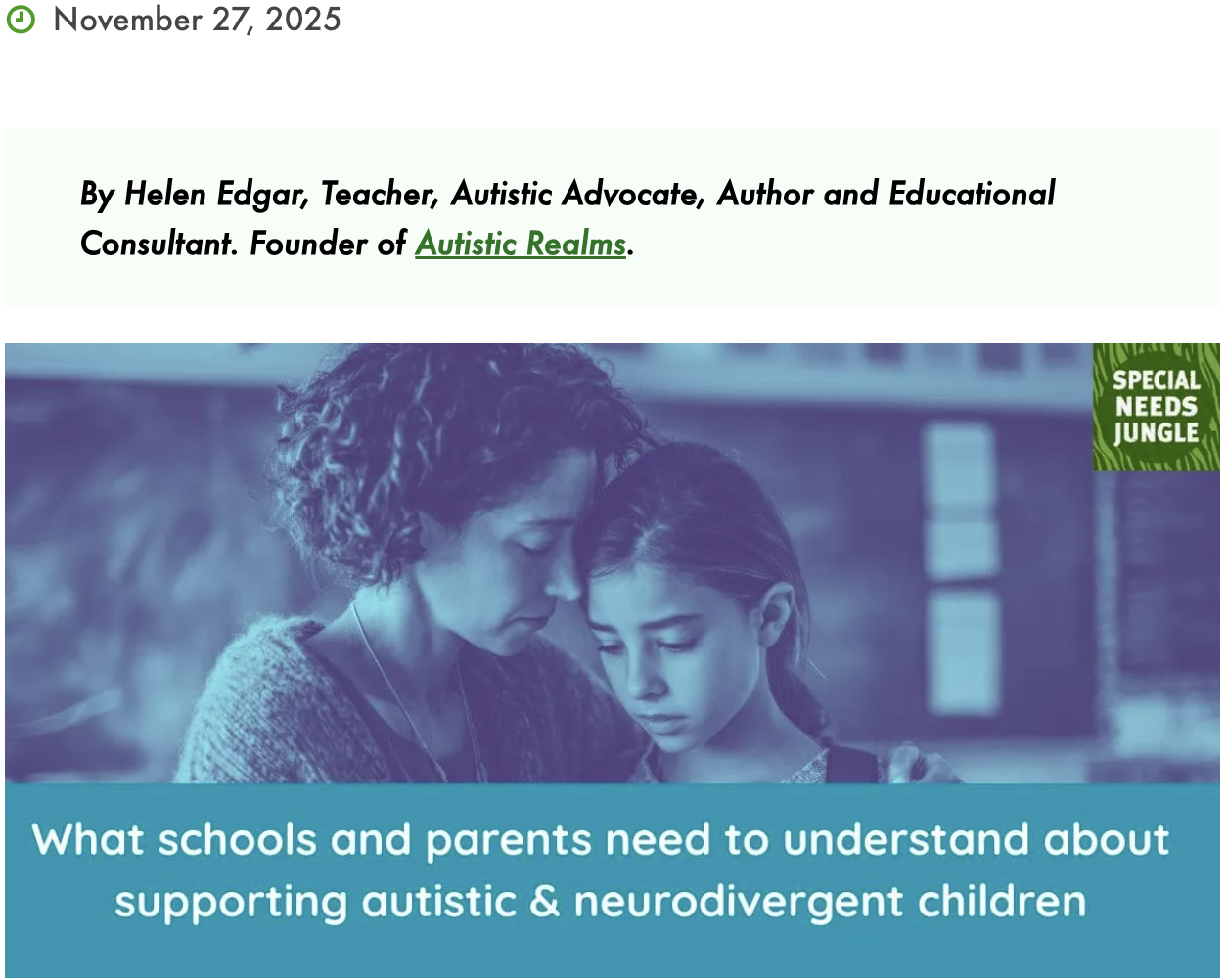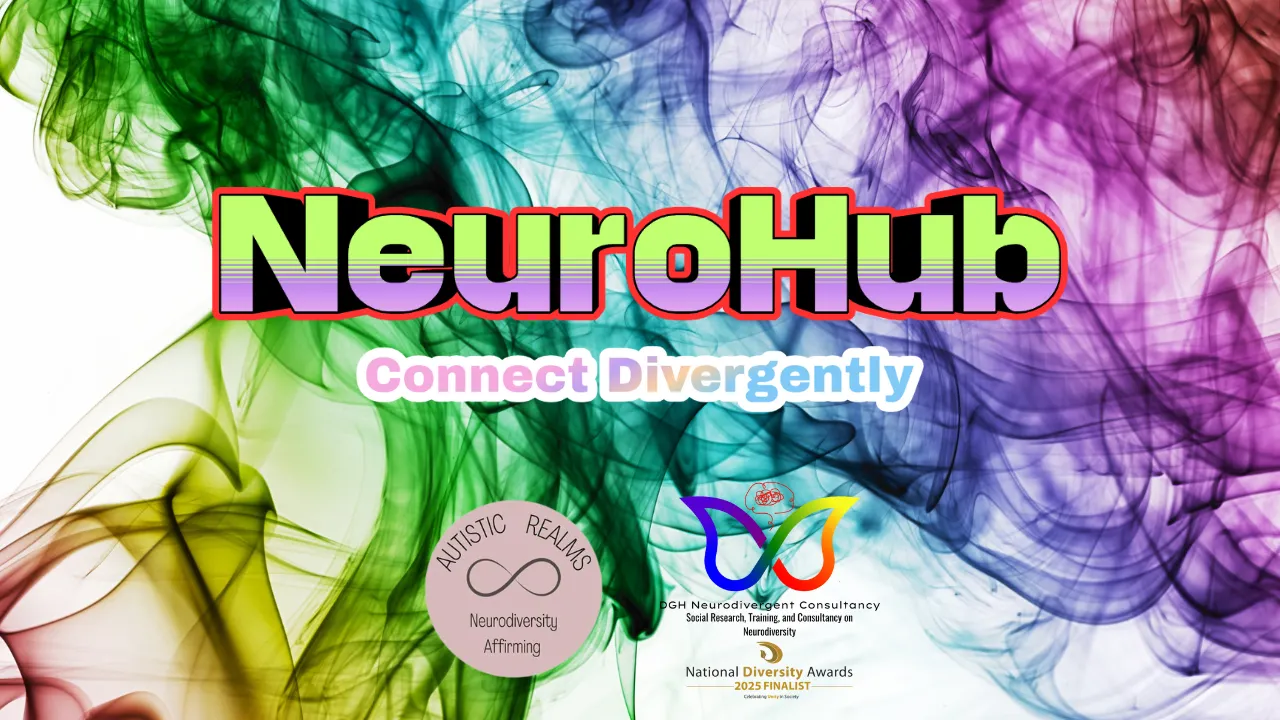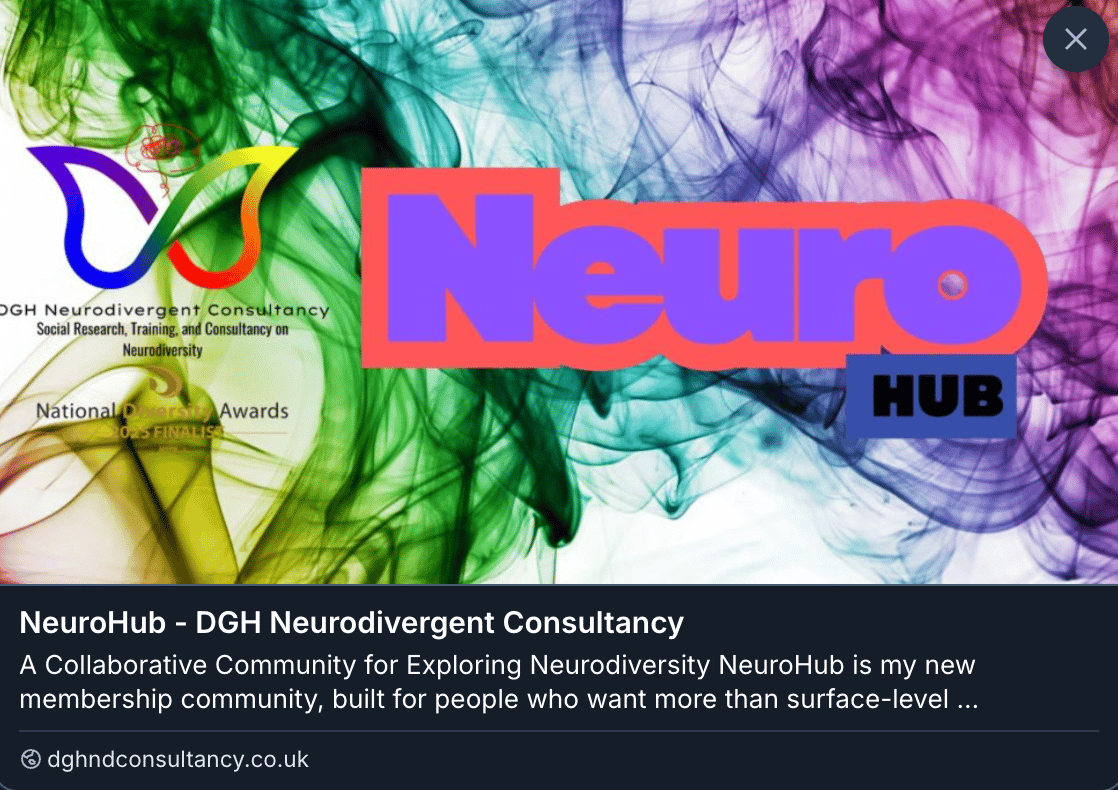Your basket is currently empty!

Quantum Neuro-Holographic Thoughts from a Liminal Space
“Quantumness tends to prosper in very cold systems that are carefully isolated rather than part of a tepid soup awash with other activity.” (Lewton, T. 2024)
This may be a weird take, but … I think we could use the idea of quantumness and reframe it around an interpretation of marginalised groups living on the edges of society, in the liminal zones. Those who are feeling deeply disconnected, isolated and frozen in a system that is not designed for us or meeting needs. This is highlighted by AutCollab’s recent research where they shared:
Our individually unique nervous systems and sensitivities develop and evolve over the course of our lives. 85% of neurodivergent adults often or always feel overwhelmed and misunderstood, and over 60% often or always feel disrespected and unsafe. Our overall sense of wellbeing is determined by alignment between our sensitivity profiles and the ecology of care we are embedded in (or not). (Jorn Bettin, Aut Collab 2024)
Collectively, our isolation can transform into something positive by our neuro-holographic energy coming together to enable neuroqueer transformations at a personal and also mass cultural level.
Disconnect at DEEP Levels in Liminal Spaces
As an autistic person, I do not see or feel a boundary between myself and my environment; I feel a deep attunement to the space around me. However, I also feel a deep disconnect with the majority of society and the pressures of feeling I need to conform to dominant social norms that have always left me on the edge; feeling separate and in many ways disembodied and shattered into millions of fractals. I experience the Double Empathy Gap (Milton, 2012) at an extremely deep level of intensity. The double empathy problem creates a gap of disconnect experienced between people due to misunderstood shared lived experiences. It is “a breakdown in reciprocity and mutual understanding that can happen between people with very differing ways of experiencing the world.”
I feel that as a society, those already marginalised are at risk of becoming even more disembodied, the double empathy gap is growing. In many ways, we are losing our primordial affinity with nature and drifting further from coherence, harmony, and the humanised ecology of care that we need. The double empathy problem feels extreme, it feels deep; it is what I have been describing as DEEP (Double Empathy Extreme Problem (Edgar, 2024).
The DEEP (Double Empathy Extreme Problem ) arises from feelings of disconnect, not only from cultural, sexual, political, religious, neurodivergent, or any other cross-section of differences but also through embodiment, or lack thereof. The double empathy gap is non-linear; it is deep, multidimensional, rhizomatic, and holographic (Mirra, 2023). DEEP could be a huge contributing factor that leads to burnout, ill health and is pushing people further out so they feel they are living on a knife edge just to survive. The DEEP gap can break people at their core, leaving them fragmented, disconnected, disoriented and disembodied, feeling like they’re falling into the void between spaces.
The DEEP problem may be intensified by being monotropic (Murray et al., 2005) and using most of my energy resources to zoom into these feelings and ways of being. This enables me to not only see the details, the harm, and the injustice but also to feel it in multidimensional synesthetic ways in how I see, feel, hear, move, and connect. All of these experiences merge and entwine in holographic ways.
I have been chatting to Dawn Prince-Hughes who is a lead in the CASY (Cultural Autism Studies at Yale) team, they describe similar thoughts and elaborate;
Because our [autistic] sensing mechanisms are super sensitive and often synesthetic (cross-sensing — for example, tasting colors or seeing sound) we often feel a part of the things around us. We don’t tend to see in hierarchies, but rather in “holograms,” as described. Always looking for connecting patterns in an overwhelming ocean of sensory, emotional, and energetic information, our relational culture focuses on how things go together and function.
(Dawn Prince-Hughes, 2024)
Neuro-Holographic Communities
“Autistic culture is a unique phenomenon; it is constantly in the process of exploring itself, defining itself, and generating itself. Unlike holistic (non-autistic) culture, it is deeply relational. For many autistic people there is no strict boundary between self and environment, or self and other. We tend not to see things in hierarchies, but in relational ways that are in constant flux. “Neuro-Holographic” is an emergent idea that our group has embraced. Neuro-Holographic, as a concept here, refers to the idea that every small bit of energy and information, whether an atom or the universe, reflects every other part of itself in a seamless and meaningful way.” (Dawn Prince-Hughes, 2024)
In my previous blog, I intentionally used a hyphen between the words neuro and holographic to represent the in-between of neurology and holographic ways of being and experiencing the world, a pause for tuning in, an embodiment, a space of Ma. I have resisted using the word “neuro-holographism as that could imply another new theory or concept. Neuro-holographic is not a concept; rather, I feel like it IS the plane of immanence on which neuroqueer theory breathes and lives; it is the ‘wave that rolls and unrolls’ other concepts (Deleuze & Guattari, What is Philosophy, 1994, p36). To resonate with the term neuro-holographic is to resonate with each other as human souls, to be embodied with your core self, perhaps with your spirit, and to be open to holographic connections with others.
Quantum Entanglement
Nerve fibres in the brain could produce pairs of particles linked by quantum entanglement. If backed by experimental observations, this phenomenon could explain how millions of cells in the brain synchronise their activity to make it function.
“When a brain is active, millions of neurons fire simultaneously,” says Yong-Cong Chen at Shanghai University in China. Doing so requires even distant cells to coordinate their timing, which has led some researchers to wonder if this coordination could be due to what Einstein called “spooky action at a distance” — the instantaneous communication that occurs between particles linked by quantum entanglement. “If the power of evolution was looking for handy action over a distance, quantum entanglement would be [an] ideal candidate for this role,” Chen says.
……Once the brain creates entangled photons, the property of entanglement could be passed onto other parts of neurons, like the protein pores that play a role in electrical signalling across the brain, says Chen. When any two objects are quantum entangled, changes in one immediately cause changes in the other — so if different parts of the brain were entangled, they could synchronise much more quickly than through any other type of connection.
Being on the edge and living in the liminal means you have a different perspective than the majority, and your bodymind will resonate differently. Your nervous system will be different and have evolved differently due to many factors highlighted by Jorn Bettin and AutCollab’s team (2024) such as:
1. traumatising experiences in earlier generations.
2. internalised ableism we encounter in our social environment
3. cultural mainstream we are immersed in
All of these factors mean that autistic people’s interoception system and exteroception system will entangle and respond differently too. Neuro-holographic people have strong open sensory gates. In our communities, we are finding neuro-holographic people are being drawn together; their holotropic energy fields seem to align with others of a similar frequency, fusing together and creating connections in all different spaces across the globe in weird and beautiful ways both online and in person. People are being led by their heart, their soul, their inner true intrinsic self and way of being and discovering that they are not alone, weirdness is ok and can be embraced.
Annie Murphy Paul in The Extended Mind: The Power of Thinking outside the Brainshows that bodily knowledge (interoception) can be more accurate, for instance in the work of day traders who must juggle huge amounts of information very rapidly, than conscious analysis of explicit data. “The heart, and not the head, leads the way,” she concludes.11 Leslie Shelton puts it bluntly: “Emotion is the master over cognition.” (Blum, S. D. 2024)
Beautiful Holographic Potential and Created Serendipity
The online community favors and enables this unique energy and connections to synchronise, entangle, fuse, form and reform and enables potential to expand rhizomatically, holographically. People and communities that are embodied and intune with each other can create serendipity. The more connected and embodied you are, the more connections form and the stronger the hologram and holographic community becomes. Each node of the hologram is a community where collective energy is created and multiplied, it enables increasingly expansive new serendipity and possibilities to emerge. It allows us to lean into and embrace neuroqueer theory (Walker, 2021) and neuroqueering possibilities.
When people feel validated, they can validate the experience of others; a sense of safety is created between people where there is trust and mutual understanding. This enables stronger connections to form in community clusters, at the nodes, which works to strengthen the rhizomatic neuroqueer network. People are in a better safer place to unravel, de-mask, and de-armour themselves from the restraints of trying to live up to neuronormative ideas when they feel they can trust and connect with those around them. Safe spaces enable radical inclusive ways for people to be themselves, so they can explore their own ways of being without stigma and without fear of prejudice. Perhaps it is only through enduring a life living in the liminal and on the edges that we can truly embrace or feel the potential of Walker’s neuroqueer theory and value the potential neuroqueering?
After years of isolation and existing in survival mode on the sidelines of the liminal parts of society, some people are naturally finding their energy is gravitating towards certain people and spaces. Like myself, they connect with others who resonate with them in small community groups, all connecting rhizomatically. Community provides a sense of meaning to life and validates what may previously have felt like a very disconnected, disembodied, chaotic existence. “Our overall sense of wellbeing is determined by the health of the ecology of care we are embedded in, by our sensitivity profiles, and our (in)ability to resolve cognitive dissonance.” (Jorn Bettin, AutCollab, 2024)
Persistent positive experiences (over months, years, decades) in the social and ecological environment beyond the human that allow us to feel understood and loved, i.e. experiences with non-judgemental animals and people with compatible sensitivity profiles — such positive experiences allow us to incrementally let go of internalised ableism, and they teach us how to nurture trustworthy de-powered (non-coercive) caring relationships with other living beings. (Jorn Bettin, AutCollab, 2024)
At a human scale, some ideas of quantum biology and quantum physics resonate with neuro-holographic concepts and ways of being. The beauty lies in the fact that the word neuro-holographic can only be felt or experienced in an undefinable, iridescent way as we are talking about energy, tiny particles of ourselves that can’t be seen or observed but are alive and seeking connections. Holographic energy is full of light and vibrations that can expand and ripple far beyond our own bodyminds to connect with others who are vibrating at a similar frequency. The fusion of this collective energy creates multiplicity and is ever-expanding, entwining, and merging with others, expanding each individual’s potential to challenge and subvert harmful systems and ways of being and discovering neuroqueer ways of embracing life in multidimensional ways. It brings people together to create ecologies of care and communities based on deep understanding, love and acceptance.
When people experience deep emotionally engaged thinking about complex issues, they are literally playing out that thinking process, our data would suggest and now many other sources of data would suggest, on the substrate of the cortisone cortical regions that literally also are feeling your guts.
Poets have had it right all along. (Immordino-Yang, 2024)
Connecting with others and following your intuition and your internal vibes or gut feelings in safe spaces enables people to explore emerging thoughts, to be open to exploring the ‘perhaps’, the ‘may be’, the ‘could be’ and possibilities that ‘might happen’ if we truly embrace the neurodiversity paradigm and neuroqueer theory in creative ways. It enables awe, wonder, and feelings of belonging. It enables our community rhizomes to expand into spaces full of radical, inclusive neuroqueer possibilities.
Opening up discussions and sharing lived experiences helps to bridge the deep double empathy gap. “A de-powered and less materialistic life is beneficial for our physical wellbeing, and that a socially de-powered life at human scale is essential for our mental wellbeing”(Bettin, 2024). We need to embrace the potential of quantum entanglement and it’s outcomes, it enables us to create new planes and plateaus to live together in our own authentic ways so we can keep holographically neuroqueering ourselves and the spaces we are in to create radically inclusive communities together.
References
Bell, J. A. (2016). Deleuze and Guattari’s What is Philosophy? In Edinburgh University Press eBooks. https://doi.org/10.1515/9780748692545
Bettin, J. (2024c, August 4). Neurodivergent nervous systems and sensitivity profiles. Autistic Collaboration. https://autcollab.org/2024/08/04/neurodivergent-nervous-systems-and-sensitivity-profiles/
Blum, S. D. (2024). Schoolishness: Alienated Education and the Quest for Authentic, Joyful Learning.
Edgar, H. (2024, June 25). Neuro-Holographic Thoughts — MoreRealms — Medium. Medium. https://medium.com/@helenrealms/neuro-holographic-thoughts-7544f6bcae70
Edgar, H. (2024, June 15). The Double Empathy Problem is DEEP — MoreRealms — Medium. Medium. https://medium.com/@helenrealms/the-double-empathy-problem-is-deep-2364b3412c39
Human Restoration Project. (2024, August 2). Keynote: Dr. Mary Helen Immordino-Yang | Solving the Frankenstein Problem[Video]. YouTube. https://www.youtube.com/watch?v=FUG_ATjjiw4
Lewton, T. (2024, May 24). Quantum biology: New clues on how life might make use of weird physics. New Scientist. https://www.newscientist.com/article/mg26234921-300-quantum-biology-new-clues-on-how-life-might-make-use-of-weird-physics/
Milton, D. (2012). On the ontological status of autism: the ‘double empathy problem.’ Disability & Society, 27(6), 883–887. https://doi.org/10.1080/09687599.2012.710008
Mirra, H. H. (2024b, April 27). Holotropism: a multi-dimensional, spacious, edgeless terrain. Medium. https://hmirra.medium.com/holotropism-1cdf99c00b74
Murray, D., Lesser, M., & Lawson, W. (2005a). Attention, monotropism and the diagnostic criteria for autism. Autism (London), 9(2), 139–156. https://doi.org/10.1177/1362361305051398
Padavic-Callaghan, K. (2024, August 1). Nerve fibres in the brain could generate quantum entanglement. New Scientist. https://www.newscientist.com/article/2441936-nerve-fibres-in-the-brain-could-generate-quantum-entanglement/
Prince-Hughes, D. (2024). Cultural Autism Studies at Yale — A meeting place for those interested in the exploration, identification, generation and preservation of autistic culture. https://culturalautismstudiesatyale.space/
Walker, N. (2021). Neuroqueer heresies: Notes on the Neurodiversity Paradigm, Autistic Empowerment, and Postnormal Possibilities.

Latest Posts
-
Autistic Burnout – Supporting Young People At Home & School

Autistic burnout in young people is real—and recovery starts with understanding. This post offers neuroaffirming ways to spot the signs, reduce demands, and truly support. 💛 #AutisticBurnout #Neuroaffirming #Monotropism #AutisticSupport
-
Monotropic Interests and Looping Thoughts

The theory of monotropism was developed by Murray, Lawson and Lesser in their article, Attention, monotropism and the diagnostic criteria for autism (2005). Monotropism is increasingly considered to be the underlying principle behind autism and is becoming more widely recognised, especially within autistic and neurodivergent communities. Fergus Murray, in their article Me and Monotropism:…
-
Map of Monotropic Experiences

Monotropism seeks to explain Autism in terms of attention distribution and interests. OSF Preprints | Development and Validation of a Novel Self-Report Measure of Monotropism in Autistic and Non-Autistic People: The Monotropism Questionnaire This map highlights 20 common aspects of my personal monotropic experiences. How many do you experience? Where are you on the map…
-
Autistic Burnout – Supporting Young People At Home & School

Being autistic is not an illness or a disorder in itself, but being autistic can have an impact on a person’s mental and physical health. This is due to the often unmet needs of living in a world that is generally designed for the well-being of people who are not autistic. In addition, three-quarters of…
-
The Double Empathy Problem is DEEP

“The growing cracks in the thin veneer of our “civilised” economic and social operating model are impossible to ignore”, Jorn Bettin (2021). The double empathy problem (Milton, 2012) creates a gap of disconnect experienced between people due to misunderstood shared lived experiences. It is “a breakdown in reciprocity and mutual understanding that can happen between people…
-
Top 5 Neurodivergent-Informed Strategies

Top 5 Neurodivergent-Informed Strategies By Helen Edgar, Autistic Realms, June 2024. 1. Be Kind Take time to listen and be with people in meaningful ways to help bridge the Double Empathy Problem (Milton, 2012). Be embodied and listen not only to people’s words but also to their bodies and sensory systems. Be responsive to people’s…
-
Autistic Community: Connections and Becoming

Everyone seeks connection in some way or another. Connections may look different for autistic people. In line with the motto from Anna Freud’s National Autism Trainer Programme (Acceptance, Belonging and Connection), creating a sense of acceptance and belonging is likely to be more meaningful for autistic people than putting pressure on them to try and…
-
Monotropism, Autism & OCD

This blog has been inspired by Dr Jeremy Shuman’s (PsyD) presentation, ‘Neurodiversity-Affirming OCD Care‘ (August 2023), available here. Exploring similarities and differences between Autistic and OCD monotropic flow states. Can attention tunnels freeze, and thoughts get stuck? Autism research is shifting; many people are moving away from the medical deficit model and seeing the value…
-
Monotropism Questionnaire & Inner Autistic/ADHD Experiences

Post first published 28th July 2023 Over the past few weeks, there has been a sudden surge of interest in the Monotropism Questionnaire (MQ), pre-print released in June 2023 in the research paper ‘Development and Validation of a Novel Self-Report Measure of Monotropism in Autistic and Non-Autistic People: The Monotropism Questionnaire.‘ by Garau, V., Murray,…
-
Penguin Pebbling: An Autistic Love Language

Penguin Pebbling is a neurodivergent way of showing you care, like sharing a meme or twig or pretty stone to say “I’m thinking of you,” inspired by penguins who gift pebbles to those they care about.
-
What schools and parents need to understand about supporting Autistic and neurodivergent children

What schools and parents need to understand about supporting Autistic and neurodivergent children
-
Join NeuroHub Community Space

Join me & David Gray-Hammond in our new community NeuroHub. Access to exclusive webinars, resources and space to connect with others! Hope to see some of you there!
-
New Community NeuroHub Space with David Gray-Hammond

Autistic RealmsHelen Edgar Autistic Advocate, Author & ConsultantNeurodiversity-Affirming Supporting Autistic People To Grow & Thrive Welcome to Autistic Realms Newsletter! Exciting news! David Gray-Hammond (Emergent Divergence) has a new community: NeuroHub! I’m really delighted to be collaborating with David and to be part of this new community space as an affiliate.Why NeuroHub?Because the neurodiversity paradigm…













